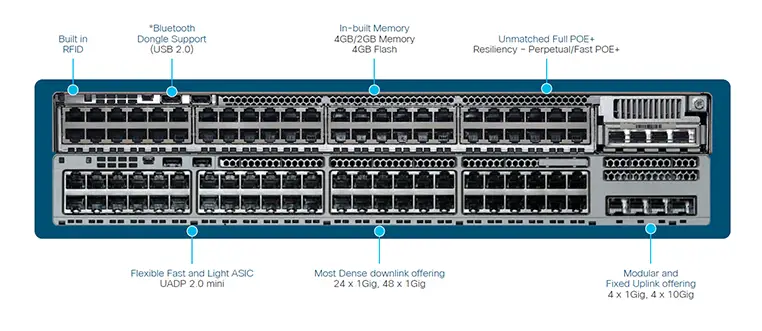Cisco Catalyst switches is built on the foundation of extending intent-based networking everywhere. It benefits from UADP 2.0 mini-ASIC which is extremely fast, flexible and light. Moreover, it supports redundancy in matter of fans and power supplies. It is also trustworthy when it comes to security and programmability by supporting macsec-128 and YANG Models.
Various uplink plink modules are available for Catalyst 9200 switches which makes it more scalable for any demanded copper or fibber-based infrastructure.

Cisco Catalyst 9200 Features
These series benefits from following features:
- Cisco IOS Lite
- Supporting 100GbE Bandwidth
- 6MB packet buffer
- Supports 1, 2.5, 5, 10, 40G port speeds
- Supports 16K NetFlow Records
- Flexible programmable modules
- SDM Templates Flexibility
- 160/80G Stacking capacity
- Up to 2X to 4X forwarding + TCAM
StackWise-160 Technology
Stacking is a feature available on Cisco small-business switches. A stack is a network solution composed of two or more stackable switches. Switches that are a part of a stack behave as one single device. As a result, a stacking solution shows the characteristics and functionality of a single switch while having an increased number of ports.
This allows users to expand their network capacity without the hassle of managing multiple devices. Additionally, switches can be added or removed from the stack as needed without affecting the overall operation of the stack. depending on its topology, a stack can continue to transfer data even if a link or unit within the stack fails.
This makes stacking an effective flexible and scalable solution to expand network capacity. A stack has a master or commander the master is the switch in the staff that handles the configuration for the entire stack. When you want to manage your stack the master unit is the device that you connect to in order to make changes.
The master also handles other important stack functions, such as detecting when switches enter or leave the stack and upgrading outdated switches. The backup is a switch that will become the new master if the original master goes offline. In this way a backup helps maintain the resiliency of the stack.
A slave or member serves as an additional unit within the stack. Unlike the master and the backup unit, the slave does not serve an additional function within the stack other than to increase port capacity. As a result, if the master and the backup units fail, the stack will become disabled Finally a stack port is a port on the switch that is used to communicate with other switches in the shack. Depending on the model a switch can have either pre-configured or user-defined stack ports.
The Cisco Catalyst 9200 Series switches enables the ability to mix multiple switches into one logical switch when connected together using special cables on StackWise-160 ports on the back. It can support up to eight switches to be connected in the stack, delivering operational simplicity and higher port density with combined switching capacity and maximum resiliency. The “160” in the name refers to the total available stack capacity: 160 Gbps.
Note: The fixed C9200L switches and the modular C9200 switches cannot be stacked together.
Catalyst 9200 Models
Catalyst 9200 (Enhanced VN) Supports for 32 virtual networks (VNs) for improved Cisco SD-Access implementation and provides 160-Gbps stacking bandwidth, full fast and perpetual PoE+ and FRU redundant power supplies and fans. (SKUs: C9200-24PB, C9200-48PB)
Catalyst 9200 Multigigabit supports wireless bandwidth optimization with 8 or 12 multigigabit ports up to 10G, up to 160-Gbps stacking bandwidth, Full fast and perpetual PoE+ and Fixed or modular uplinks. (SKUs: C9200-24PXG, C9200-48PXG)
Catalyst 9200 (Modular Uplinks) supports swappable network modules with 4 x 1G, 4 x 1/10G, 2 x 25G, or 2 x 40G uplinks, 160-Gbps stacking bandwidth, data and full fast and perpetual PoE+ options and FRU redundant power supplies and fans. (SKUs: C9200-24T/P, C9200-48T/P/PL)
The C9200L supports fixed uplinks of 4 x 1G, 4 x 1/10G, or 2 x 1/10/25G, 80-Gbps stacking bandwidth, data and full fast and perpetual PoE+ options and redundant power supplies and fans. (SKU: C9200L-48PXG, C9200L-24T/P, C9200L-48T/P/P)
Catalyst 9200 Uplink Modules
The Cisco Catalyst 9200 Series modular SKUs (C9200) support four optional network modules for uplink ports on all models. Uplink modules are supported on Catalyst 9200 Series modular models (C9200).
Cisco Catalyst 9200 License
Cisco Catalyst 9200 series only support Cisco smart licensing which is explained below.
Cisco Catalyst 9200 Smart License
All product instances in Cisco Catalyst 9200 switch could be registered by a valid purchased smart license placed in the smart account in the Cisco Smart Software Management. However, Using Cisco PLR smart license is the best way to register your Cisco 9200 switches permanently.

You can get help from our specialists on the price and order in different ways. Just by clicking on “order now”, the needed details will be sent to you as fast as possible.






